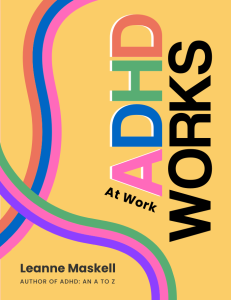To be a neuro-inclusive employer is to value, support, and harness different ways of thinking at work. Neurodiversity recognises the endless variation of ways that human brains differ, which underpins everything we do, including how people work as individuals and with one another.
If someone is neurodivergent, the way their brain works may differ from what is broadly accepted to be ‘normal’, which may become apparent in the workplace. For example, ADHD is linked with a 30% developmental delay in executive functioning skills.
However, being different doesn’t mean being difficult – it comes with many unique strengths and skills which others may not have.
A ‘one size fits all’ approach within the workplace hinders engagement, productivity, inclusivity, and people from reaching their full potential. Neuro-inclusivity unlocks more effective ways of working for everybody, creating a culture where people are accepted as they are.
Here’s how employers can make it happen:
1. Be pro-active and holistic
Neuro-inclusion cannot be achieved with isolated strategies, such as by solely hiring neurodivergent people. Without pro-active change, they will be simply operating within workplaces that do not accommodate their ways of thinking, and forced to mask as a result.
It’s also likely that employers already have many neurodivergent employees – they just don’t know it. For example, research found 53% of tech employees were neurodivergent, but employers believed this was only 3%.
Employers must pro-actively tackle barriers to accessibility within an organisation, right from recruitment to performance and progression, identifying how disclosure or support may be relevant at differing points. This is key to ensure that efforts do not simply ‘check a box’, but see effective results and real changes.
Employers can establish neurodiversity policies, setting out processes for employees to request and implement changes to the way things are ‘normally’ done, to aid neuro-inclusivity. In an ideal world, these would be available to everybody regardless of whether their neurodivergence amounts to a disability under the Equality Act 2010, triggering legal duties on employers to make reasonable adjustments to reduce the disadvantages they experience at work because of their disability.
A truly neuro-inclusive workplace accommodates everybody, all the time. For example, instead of working from home being available only as a formal reasonable adjustment, the option could be accessible to everyone, fostering a working culture of personal responsibility and trust.
2. Provide education and training
Conversations around neuro-inclusivity can feel vulnerable for employees, because there’s often no clear answers. For example, if you’ve met 1 person with ADHD, you’ve met 1 person with ADHD – how this may manifest within the workplace will be different for everyone.
 Neurodiversity is also becoming more politicised, with media articles and prominent figures in our society often stigmatising those seeking support, such as by suggesting conditions like ADHD are a trend. This is due to a collective increase in awareness (ADHD was not diagnosable in UK adults until 2008!), but as healthcare systems are unable to handle years-long waiting lists, people are often left without support.
Neurodiversity is also becoming more politicised, with media articles and prominent figures in our society often stigmatising those seeking support, such as by suggesting conditions like ADHD are a trend. This is due to a collective increase in awareness (ADHD was not diagnosable in UK adults until 2008!), but as healthcare systems are unable to handle years-long waiting lists, people are often left without support.
As employers, it can feel uncomfortable to not have the answers. Managers may direct conversations to HR, who may refer to Occupational Health, and conversations about simple accommodations may bounce around in a bureaucratic game of ping-pong. The human being at the centre of these conversations may suffer as a result – 1 in 5 neurodivergent employees have experienced harassment or discrimination at work.
It’s important for employers to recognise that they don’t need to be medical professionals to have adult conversations about how to best support employees. Having policies in place provides important structures and instructions for neuro-inclusion at work, setting out remits and processes such as accessing budget for adjustments (although the average cost is £75, and many are free).
Training employees on disability ensures they understand the legal duty to make reasonable adjustments under the Equality Act, and how this interlinks with other forms of flexibility at work, such as the flexible working hours. Reasonable adjustments should be recognised as such, and properly implemented, recorded, and reviewed to ensure that disabled individuals are accessing the support they need to perform as their colleagues are able to.
Providing every employee with neurodiversity training ensures they are best placed to understand how to communicate and work most effectively with their colleagues as a team, and access support where needed. Training should also be tailored to specific situations, such as specific training on a neurodevelopmental condition for managers where somebody they manage has disclosed this.
3. Fit jobs to people – not the other way around
At a macro-level, our world is progressing to one where jobs can be adjusted to individuals, instead of expecting one person to be able to ‘do everything’. By focusing on strengths, rather than weaknesses, employers can harness every individual’s unique skillset and thinking styles to cultivate careers where they can thrive and contribute their full potential.
Removing barriers to accessibility empowers individuals to focus their energy on their work, instead of masking their symptoms. Creating a psychologically safe culture where employees feel safe enough to ask for help reduces inefficiencies and mistakes, fostering a collective sense of belonging and acceptance.
The benefit of this management style can be illustrated with the ‘interest based nervous system’ linked with ADHD. As we are motivated by interest, novelty and adrenaline, stimulating and challenging work may literally feel easier than administrative or repetitive tasks. Assigning tasks to suit each individual’s ‘zone of genius’, where they can hyper-focus and play to their strengths, will result in extraordinary work from everyone, with teams working together.
Employers can implement this by taking time to understand individual’s strengths and challenges, and encouraging ‘task-swapping’, empowering employees to support each other.
The Covid pandemic demonstrated the innate flexibility of jobs where needed – we shouldn’t have to be in crisis for jobs to work for the individual, instead of an outdated system that ultimately benefits nobody. Neuro-inclusion and accessibility means everybody benefits – it’s a no-brainer.
About the Author
 Leanne Maskell is an ADHD Coach, Director of ADHD Works and author of the new book ADHD Works at Work.
Leanne Maskell is an ADHD Coach, Director of ADHD Works and author of the new book ADHD Works at Work.




































